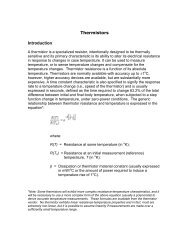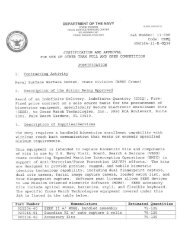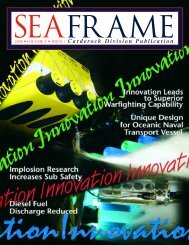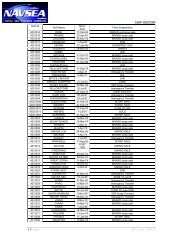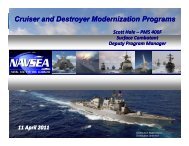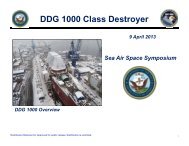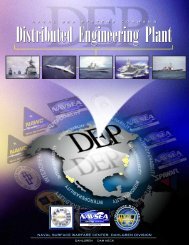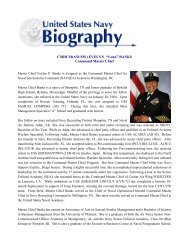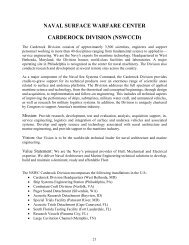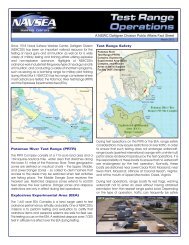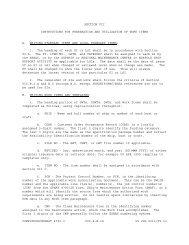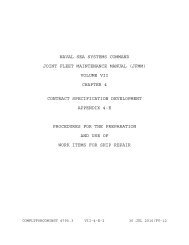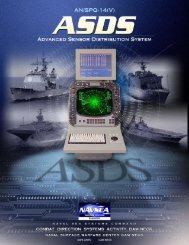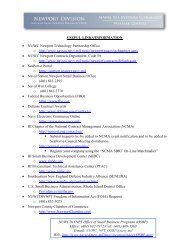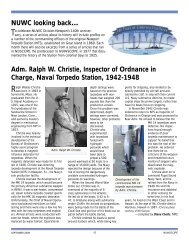Volume 6, Issue 1 - Naval Sea Systems Command - The US Navy
Volume 6, Issue 1 - Naval Sea Systems Command - The US Navy
Volume 6, Issue 1 - Naval Sea Systems Command - The US Navy
Create successful ePaper yourself
Turn your PDF publications into a flip-book with our unique Google optimized e-Paper software.
Above: <strong>The</strong> <strong>US</strong>S Ronald Reagan (CVN 76) navigates through heavy<br />
seas in the Pacific Ocean. An aircraft carrier can exhibit as much as<br />
27 feet of vertical pitching movement from such wave action.<br />
U.S. <strong>Navy</strong> photo.<br />
Because the waves measured by the buoy are not the same<br />
waves that the deep-draft ship would actually experience,<br />
a statistical formula is applied to the predicted motion to<br />
yield an expected extreme vertical displacement. In that<br />
way, a worst case scenario would be used in calculating the<br />
predicted underkeel clearance. <strong>The</strong> process was validated by<br />
comparing data from the inertial navigation system of one of<br />
the submarines as it passed the buoys by the channel with the<br />
predicted motions from EMOGS using the measured waves in<br />
the channel.<br />
<strong>US</strong>S Pennsylvania (SSBN 735) was the first ship<br />
to transit the 11-mile long entry channel to the Kings Bay<br />
port, using EMOGS as an advisory source of information in<br />
1989. <strong>The</strong> submarines have used EMOGS guidance for every<br />
channel transit since that time. In 1995, EMOGS was also<br />
installed at Port Canaveral to provide underkeel clearance<br />
guidance for SSBN transits of that channel as well.<br />
EMOGS met with great success at Kings Bay,<br />
and the technology was used to counter another potential<br />
grounding situation which aircraft carriers might face<br />
Core equities<br />
Left: <strong>The</strong> long wave periods shown in this photo<br />
indicate the importance of wave action in<br />
figuring the required underkeel clearance for a<br />
ship, especially an aircraft carrier, to navigate a<br />
harbor channel without grounding.<br />
Photo provided by Andrew Silver, NSWC Carderock Division.<br />
Below: A diagram showing some of the factors taken<br />
into account when determining the clearance<br />
between a ship’s keel and the bottom of the channel.<br />
<strong>The</strong> EMOGS/CADET programs save the <strong>Navy</strong> millions<br />
of dollars in dredging costs per year.<br />
Graphic provided by Andrew Silver and rerendered by Gary Garvin, both<br />
NSWC Carderock Division.<br />
while moving through channels in the San Diego approach<br />
area. Because an aircraft carrier can have as much as a<br />
27-foot vertical movement due to its environment, a range<br />
of channel depths were studied for San Diego. This study<br />
determined a channel depth that provided the most number<br />
of days per year of safe transits by using the probability<br />
of occurrence of different wave conditions from a 20-year<br />
wave climatology off the San Diego channel. Using the<br />
traditional deterministic methods, the safest dredge depth<br />
the <strong>Navy</strong> would have had to dredge the channel was 60<br />
feet, whereas the new probabilistic method calculated a<br />
safe depth of 55 feet. <strong>The</strong> 5-foot difference in required<br />
dredge depth saved the <strong>Navy</strong> $16 million in dredging<br />
and precluded the possibility of dredging up additional<br />
hazardous materials from the channel bottom.<br />
From the procedure used at San Diego, an<br />
application known as Channel Analysis and Depth Evaluation<br />
Tool (CADET) was born. CADET is used to predict the<br />
ENVIRONMENTAL MONITORING (Continued on page 16)<br />
SEAFRAME<br />
15



